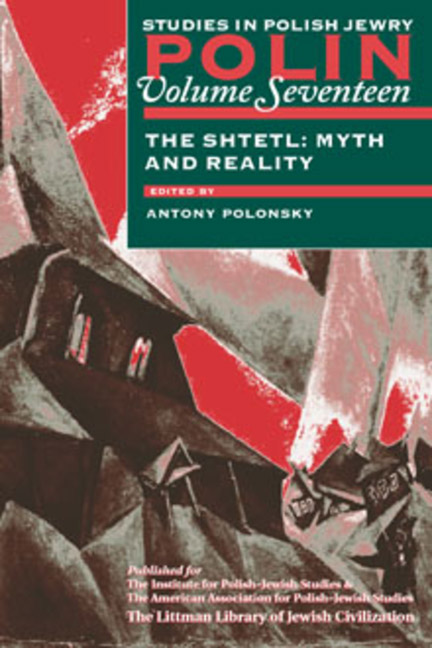Book contents
- Frontmatter
- Dedication
- Editors and Advisers
- Preface
- Polin
- Polin: Studies inPolish Jewry
- Contents
- Note on Place Names
- Note on Transliteration
- List of Abbreviations
- PART I THE SHTETL: MYTH AND REALITY
- PART II NEW VIEWS
- PART III DOCUMENTS
- PART IV THE SIXTY-FIFTH ANNIVERSARY OF EVENTS IN PRZYTYK: A DEBATE
- If Not a Pogrom, Then What?
- Pogrom? The Polish–Jewish Incidents in Przytyk, 9 March 1936
- It Was No Ordinary Fight
- Life and History
- Letter from Ryszard Fenigsen
- Przytyk and the Market Stall
- PART V REVIEWS
- OBITUARIES
- Notes on the Contributors
- Glossary
- Index
Life and History
from PART IV - THE SIXTY-FIFTH ANNIVERSARY OF EVENTS IN PRZYTYK: A DEBATE
- Frontmatter
- Dedication
- Editors and Advisers
- Preface
- Polin
- Polin: Studies inPolish Jewry
- Contents
- Note on Place Names
- Note on Transliteration
- List of Abbreviations
- PART I THE SHTETL: MYTH AND REALITY
- PART II NEW VIEWS
- PART III DOCUMENTS
- PART IV THE SIXTY-FIFTH ANNIVERSARY OF EVENTS IN PRZYTYK: A DEBATE
- If Not a Pogrom, Then What?
- Pogrom? The Polish–Jewish Incidents in Przytyk, 9 March 1936
- It Was No Ordinary Fight
- Life and History
- Letter from Ryszard Fenigsen
- Przytyk and the Market Stall
- PART V REVIEWS
- OBITUARIES
- Notes on the Contributors
- Glossary
- Index
Summary
THE last political trial conducted in Radom before the Second World War was of a different character. On 9 March 1936, a market day, in the town of Przytyk near Radom, the fighting squad of the Endecja (National Democratic Party) provoked a pogrom during which the shoemaker Josek Minkowski and his wife, Chaja, were killed and several dozen Jewish residents of the town, including women and children, were severely beaten. Several of the Jews of Przytyk had firearms and shot into the crowd. A man by the name of Stanisław Wieśniak was killed and three people were wounded. Forty participants in the pogrom and fourteen Jewish defendants were brought to trial at the District Court in Radom. The latter were defended by the Warsaw lawyers Ettinger, Szuman´ski, Margulis, and Kruger. My father lodged a civil claim for a ‘symbolic zloty’ on behalf of the orphans of the murdered Minkowskis. The lawyer Kowalski, leader of the Obóz Narodowo- Radykalny (National Radical Camp) in Łódź, made a similar claim on behalf of the family of Stanisław Wieśniak. The trial was conducted in a tense political atmosphere. Correspondents for several dozen national, European, and American newspapers came to Radom, and various other personalities arrived as observers. My father's speech clearly did not please the correspondent of one of the Warsaw papers; he gave the speech the title ‘The Last Epigone of Assimilation’. The Przytyk trial was of historic importance; historical studies and collections of documents related to this case are published even today, sixty years later. In any case it was the most memorable episode of my father's career.
It is curious that, when I recall my father, what comes to mind first is not the quality of his intellect or his professional achievements, but rather his courage and his excellent reflexes. On the first day of the Przytyk trial a ‘rent-a-crowd’ suddenly appeared in the entrance to the block of flats. This was the fighting squad of the Oboz Narodowo-Radykalny, come to ‘dissuade’ my father from going to the courthouse. My father called to me: ‘Put the dog on a long leash and come with me.’ When our large bulldog appeared, the entrance emptied out in the blink of an eye.
- Type
- Chapter
- Information
- The Shtetl: Myth and Reality , pp. 400Publisher: Liverpool University PressPrint publication year: 2004



